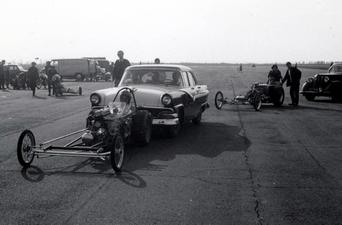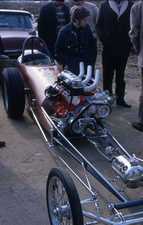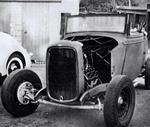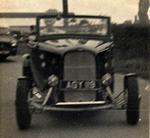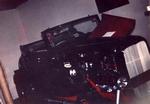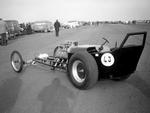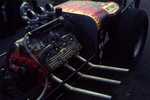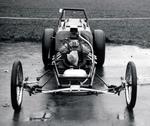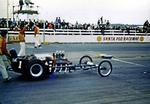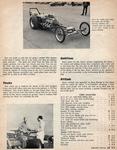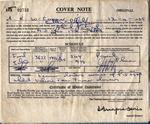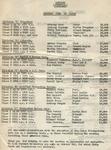
As told exclusively to Ken started building his first dragster in 1960, meeting other British Hot Rod Association dragster constructors at their first Custom Car Show in 1963. RAC regulations put the project on hold and Ken hot rodded a '33 Ford Cabriolet for the first BHRA AGM. He resumed work on the dragster, completing it by the end of 1964 and took it to the BDRA Practice Day at Graveley in August 1965 when there were eight UK-built slingshots. Ken then took it to the first meeting at Santa Pod, recalling some of the personalities of the time. Back in the 1950s when I was reading the American hot rodding magazines, I kept looking at the drag racing and at the cars running then which were pretty primitive. I started to be aware of how fast they were going. When you think 100mph in this country back then was a quick car. I was working in the motor trade and when I went out on the road with a Jaguar or something like that you could just about get 100mph out of it and that was a quick car, but it was an expensive sports car. Then I see these rather crude Dragsters built out of all Ford parts and axles doing 120mph, in 440 yards!!! I thought that's amazing. At first, I thought it can't be right, you know, not in a short 440 yards from a standing start, I was really intrigued with that. Having my ‘37 Coupe I'd collected spares and stuff around it and within 18 months or so I'd collected axles, gearboxes, wheels and other Ford parts like you do. I looked at it and I thought, I can virtually put all this pile together and with a couple of tubes I've got a dragster like the Americans. That sort of spurred me on a little bit really. I thought I could build a dragster and I actually did it with a friend of mine. I started it in 1960 the same time as Sydney Allard. We mocked it up one day, put the engine, gearbox, some axles together and some bits of tubing. I thought well, this is virtually a dragster this is. How good, but where the hell would you run it? There's no drag racing in this country, nothing at all. Allan Herridge was building a Dragster and that's how I got to know Brian Sparrow, John Harrison and Robin Evemy, a little group of guys down in London who called themselves Dragster Developments. The BHRA put out a very simple newsletter with progress on what was going on. Then we had the first Custom Car Show at John Bennett’s Spa Engineering early in 1963 and I saw Allan's dragster there. He'd built it to suit the RAC racing car regulations. So, he’d got front wheel brakes, the exhaust cleared the tires, and he got this, that and the other. I was scoffing at it, because I hadn't got front wheel brakes on mine. I’d built it like the Americans, then Brian Sparrow says you won't be able to run it. What do you mean? Well, it's got to conform to the racing car rules by the RAC, you’ve got to have four-wheel brakes, you have to cover the engine up, you can't have advertising, the exhaust has to clear the tyres, you’ve got to have a cushion in the seat three inches... I can't do that, I'm not going to compromise it, that ain't a dragster to me. So rather disgruntled I dismantled it, took all the parts off and dumped the chassis down the back of the garden at my parent's house. That’s when I decided to build my hot rod as I'd found a 1933 Ford Cabriolet, and I thought I'll try to build a real California style hot rod this time and got about 80% done. I got it on the road, taxed and insured, but it wasn't quite finished how I wanted it. I’d fitted a ‘48 Mercury flathead and ‘39 Mercury hydraulic brakes. The heavy fenders and running boards came off, replaced by small motorcycle fenders. I wanted a classic ‘32 grille but couldn’t find one anywhere ending up buying a complete 2-door 1932 Sedan for £10 just to get the grille which I shaved like they did in America and put it on. It was pretty well there, looking pretty good.
Then I had a phone call from Brian Sparrow, you'll be pleased to know the RAC have dropped the racing car rules. You can run a car without front wheel brakes, blah, blah, blah... Well, I then lost interest in my hot rod because I was really hooked with dragsters and I dragged the chassis out the weeds from the bottom of the garden. The ‘64 Drag Festivals were the big turning point for the RAC who after seeing the American dragsters run could now see you didn't need front wheel brakes; it was perfectly safe to run a car with just back wheel brakes. With a bit of lobbying from Allard and Co they relinquished the rules which was wonderful really. They were still a bit dicky about advertising on cars, they wanted the Americans to take all the decals off their cars. Allard said, all these sponsors have put up the money to bring the cars here. You know they're gonna keep them on whether you like it or not. It's thanks to all the sponsors we've got these cars over here. It's American stuff anyway, so it's not doing any harm to us is it? So, he defied the RAC, that was a turning point and we could have decals. They didn't like it but we did, it was wonderful to have a pair of Mooneyes on your car, you know, something as simple as that. I sold my hot rod which was a shame because it wasn't really finished. It still exists and has been restored back to stock in Sweden. I've seen it and I've had a ride in it when it came over about three years ago to Pendine Sands, it's exactly my car. I know for a fact as I saw some washers under the hood that I welded on to hold some springs to stop it rattling. There's still some red paint on the engine mountings. I’d painted the chassis red like the Americans did so I know it's my car and it's also still got de-arched springs with the eyes turned up.
After spending a year or so in the garden the dragster chassis was badly corroded. I turned it upside down, scrubbed off all the rust and corrosion and I had some Polyfilla which was Dad’s and I used this to disguise the corrosion, filling some of the holes, I put some paint on it and carried on putting it back together. I put it together with no front brakes just like the American dragsters. So, by the end of 1964 I’d got myself what I thought was a dragster.
Now I could go drag racing, which I thought was wonderful. I ran it at the BDRA Graveley Practice Meets. That’s how the Gleadow brothers got involved, their dad had a Tea Wagon there and they saw all these funny looking cars and became hooked. More and more dragsters were being built and at the August ‘65 Graveley Meet eight slingshots turned up. There was me, Allan Herridge, Harold Bull, Nobby Hills, Derek Metcalfe, Les Turner, Leon Moss and Colin Glass, all pioneers.
When I built the chassis, I hadn’t got the means to bend tubes. For part of the cowl, I wanted some curves, hoop shapes and I looked through the tip at work. When I worked at the garage, we’d got an old tyre rack made out of tube and I looked at some of the bends and said right I’m having that got the hacksaw out and used these. The roll cage as such was just angles squared off but a lot of the curves were of the tyre rack, so I didn't waste anything really. I’d got some steering columns and only wanted the steering tube shaft and box. The outer tube that went up from the floor I’d got two of them and I cut them into six pieces and I made the exhaust headers out of those. Nothing was wasted, it was a real economy car. I used the Mercury engine from my Cabriolet in the dragster which had a nice camshaft, a stroker crankshaft, a three-carb manifold and other bits and pieces. I’d bought a Pilot engine, had that bored to Mercury size and fitted that into the Cabriolet with a twin carb manifold before I sold it. The Mercury engine was a nicer motor. I wouldn’t sell the better engine with the car but the Pilot engine was nice and lively and it ran well. Ironically the guy who brought it left it with water in it over the winter, it froze up and the block cracked and it was scrap. That’s when Tony Whitehouse brought it with the scrap motor.
In the dragster I fitted a Ford side shift gearbox out of a V8 Pilot and Ford rear axle out of a Mercury, it was not narrowed just stock width, a lot of heavy stuff. I had to put hydraulic brakes on it and I got them from an Allard out of a scrapyard as it had hydraulic brakes on a ford axle, I thought it would fit okay but it was a weird stud pattern on the Allard. Working in a garage, I’d tried every wheel of every car known to man and not one wheel fitted. In the end I found out it was the same stud pattern as a Bentley so I had to find a bloke who specialised in breaking Bentleys. He wanted horrendous money for a pair of wheels. He wanted fifteen quid and he wouldn’t budge. Wheels from a scrapyard back then where only 10 bob, 50p. He said they’re off a Bentley, I said they were only wheels made by Ruby Owen but he wouldn’t budge, so I kept the original stock 5-inch wide Allard wheels with ordinary Dunlop street tyres on it and I ran it like that for a bit. Of course when you get to Graveley with everybody else there, you have your doubts then, is it going to be quick enough or is it going to be embarrassingly slow? Much to my surprise by the end of the day I’d run 100mph. I know it’s nothing but I was really pleased with that because there weren't many cars doing that. I called the car Bazooka because Americans had Bazooka guns they used during the war. It’s a little-known fact I’m a very keen model aircraft builder and I’ve flown model airplanes since I was about 7 years old. I’ve still got about 70 of them next door. In the late 40s and 50s there was a super-hot airplane called Bazooka. It climbed like a rocket and I built one of these airplanes and it went up like a rocket and fast.
I was going to call the car Road Runner but when I turned up at Graveley one of the Americans, Bill McKee from the USAF Base had got a Chevy Impala and he’d got the Road Runner cartoon on the door and called it that. So, I thought I can't call it that after all and I decided to call it Bazooka. Then of course he went back to the States and took his car with him and the name had gone. I later narrowed the rear axle and I was offered a pair of Dunlop racing tires off an ex-Graham Hill BRM for a couple of quid the pair and thought wow, they’ve not cost me much so I can afford £15 for those Bentley wheels, of that nasty man. I thought my total outlay was only going to be £17 and I’ve got some nice racing tires. Luckily a friend of mine, Godfrey said I’ll go and pick up the wheels for you, so I gave him the money he went over there and got them for 10 quid. I don’t know how he did it but for 12 quid I’d now got racing tyres on my dragster. I also fitted a pair of aluminium Edelbrock cylinders heads.
Gravely started at the end of 1964 and they ran through 1965 and into 1966. I’m sure I also went to Duxford, I did go to Church Lawford, that was an awfully rough surface. I went to Long Marston; it had still got the military boats upside down as barriers. They had these military landing craft called ducks like a flat-bottomed punt with wheels on, they weren’t very big they were military surplus. They were turned upside down and put all along the sides of the strip. The Jaguar Owners Club and Thames Estuary Automobile Club sponsored meetings at Long Marston. We were unique with our dragsters. There was just me, Allan and I think Derek Metcalf and Ken Bunce. You had to have a good reason to buy parts from America back in the 1960s. You had to get a banker's order and fill in what parts you wanted. There was nobody you could get them from in England. When I started to build my Cabriolet hot rod, I wanted some speed equipment. Looking down the adverts in Hot Rod Magazine, there was Shells, in Santa Monica and at the bottom it said we ship all other the World, I thought wow. I wrote to Shells to see if they would ship to England and what they’d got for sale as they had piles of second-hand stuff. They sent me a list with so many parts it was just mouth-watering everything you could think of for an engine. I looked at the prices and couldn’t believe how cheap the stuff was. I needed to get some dollars. Luckily, I knew a lad who worked at Cooks Travel Agency and they dealt in currency. You could only go abroad with a limited amount of currency to certain places and America was one. It was to do with Britain’s debt to America from the war. This lad could get $5 or $10 dollars at a time. So that’s what we did, he’d come up to the pub on a Friday night with an envelope, I’ve got you $5, so once I had enough, I got back onto Shells with a list of parts. They offered to keep the parts for a week which were all Flathead parts: a 3-carb manifold, Wilcap flywheel, camshaft and a few other parts. It came to a ridiculous sum like about $25 dollars which was ever so cheap, then the freight charges. I just posted the $30 dollars and hoped the person at the other end was honest and did not pocket the cash but everything went well and I received all the parts into Liverpool docks in a wooden box. Well, to show their gratitude inside were three almost brand-new Holley 94 carburettors which I hadn’t ordered. The manifold was $17.50 on its own. So, trying to get American parts in 1963 turned out okay. I was at Mere Green service station then and the parts had arrived when I got home, Mother said a van’s dropped off a big box for you. I put these parts onto the hot rod first before using them on the dragster. Going back to my model airplane situation I’ll tell you what it was like. It would be about 1952 when I was still at school, one of the guys in the Walsall Club was very friendly with some Americans. When they got back, they sent him some American model airplane engines which were the thing to have, they made superb engines. So, this guy Cliff Petty received three or four engines, Ohlsson 60s and Arden 19s and everybody was drooling over this. Then some spiteful sod reported him and the police came round and confiscated them and said how have you got these engines? He said they’re gifts, well we’ve heard all that before. How have you paid for them? I haven't paid for them, some American friends sent them to me. They didn’t believe him. Cliff got them back in the end as he proved they were gifts, but that’s how bad it was. During my time at Eastcroft Garage, ‘52 - ‘65, one of our customers was Mr Eric Miles who lived about 150 yards away. Having no garage or parking space I had to rent a lock-up at the rear of Eastcroft, so I saw him almost every day, plus we maintained his car which I drove hundreds of times during the 13 years I worked there. When I obtained my ‘33 Cabriolet I rented a lock-up at the rear of number 2 which as it happened was next to Mr Miles so I saw him a hell of a lot. A nice gentleman, very soft voice. Why am I telling this?... Well, his son of course was Ken Miles! Who with Carroll Shelby developed the GT40 which won Le Mans in ‘66. (a recent film) While I was building my hot rod Mr Miles senior would stop and chat, and tell me how his son was doing. This would be ‘61/62 when Ken was having success racing Sunbeam Alpines. At that time, he had a Rootes garage in North Hollywood but couldn’t get mechanics to work of them. In fact, he had a sign outside: - ‘English Mechanics Wanted’ And you know what’s coming next! So, for the next two or three months, every couple of weeks or so, Mr Miles would stop and try to get me to go Stateside and work for his son Ken. Good job I didn’t as sometime later the USA Government seized the business and assets for non-payment of taxes! Whew! Anyway, sometime around ‘65/66, one Saturday lunchtime driving home from the lock-up in my ‘37 Coupe, in my rear-view mirror I saw a red Mustang getting closer. As I climbed up the hill at about 60mph the Mustang swung out and drew level. It was left hand drive so we were about 6/7 feet apart. With a slight smile the driver looked at me and floored it, probably hitting 80mph as he crested the hill. Sadly, that was the last time I would see Ken Miles. He was killed shortly after. (John asked Ken about his memories of Allan Herridge and John Harrison.) John was very quietly spoken and never said much; he was a lovely man. I won’t hear a word against him. If he’d got a failing which wasn’t really a failing, he wanted to do and make everything himself and was averse to having to buy a part. He was like me, but he carried it a bit too far. He wouldn't buy a decent bullet proof clutch; he was adamant he could build just as good a clutch as the Americans could sell him one. He had nothing else but trouble with it. It was forever packing up and coming apart.
Allan used to get onto him, why don’t you buy a clutch but John always thought he could make one better but he couldn’t. So, he had a lot of trouble with his car because he insisted on making a lot of the crucial parts. We all tried to explain to him it was dangerous. If the clutch came apart it could cut the car in half, then it could cut your legs off. It was very much a safety thing as well as reliability. It was a failing of his although he was very good at what he did and his car was nicely made. I went to the lockup garage that Allan had several times which was behind a block of flats where he lived and he gave a few quid to the lady he rented it from. He ran a cable through her kitchen window for power. Allan had started building his Cadillac powered car, I’d go down there for parts and also visit John just around the corner where he was working on his DD Atlantic dragster. Allans wife was very good and would cook me a Sunday dinner. Allan’s DD Buick dragster was put on display at the Birmingham Motorists’ Fair Bingley Hall alongside my Cabriolet in February 1964. The BHRA had their own stand. John Bennett brought the Dragster up for the show and 3 days later I took it back to Brian Sparrow's place in Tylers Green, Buckinghamshire. Because I took his car back for him and looked after it during the exhibition, he said I've got a couple of magnetos here that might be useful for you. I won’t be using them, they’re in the coal house somewhere, I’ve tried them out as I got the missus to hold them while I flicked them over and she jumped a mile. I made one good magneto out of the two and ran that right up until the 1980s. It went back to Lucas to have it rewound but Allan gave me my first magneto. I had the misfortune to have a chipped lobe on my camshaft. Allan said I’ll repair that for you and used a cobalt rod, welded it up and ground it to blend it all in. I ran that camshaft until the 1980s when I sold the car with it. He also turned me a flywheel out of boiler plate. I didn't want a cast steel one but an explosion proof flywheel. There was no ring gear needed then of course as we pushed started the dragster. We were very good mates Allan and I, which was inevitable, although we were miles apart only there was really no one else into the drag racing scene back then. It was so unusual then to find anyone else interested in drag racing and those few of us who where we all lived so far apart, like Clive Lingard in Manchester about 100 miles away. Gallery: click on any thumbnail for a large image.
Back to pioneers index Back to News page |










































